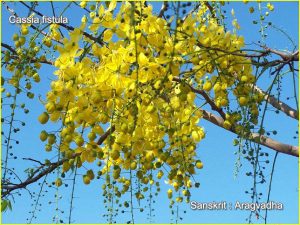 Common name Purging cassia (E), Amaltas (H) Sanskrit A-rag-vadha Latin Cassia fistula–Fructus, Folium (Caesalpiniaceae)
Common name Purging cassia (E), Amaltas (H) Sanskrit A-rag-vadha Latin Cassia fistula–Fructus, Folium (Caesalpiniaceae)
The general use of this plants are- A gentle laxative used to clear pitta from the intestines. The fruit-pulp, root-bark and leaves of Aragvadha is used in the form of fruit-pulp, decoction to treat fever, jaundice, diabetes, skin diseases, wound, rheumatic ailments, erysipelas, wound due to accident.
ENERGETICS
Rasa (taste) Sweet
Vırya (energy) Cold
Vipa-ka (post-digestive effect) Sweet
Guna (quality) Heavy, unctuous
Dosa effect VPK–
Dhatu (tissue) Plasma, blood
Srotas (channel) Digestive, circulatory
Jaundice
Aragvadha, in the dose of 40gm, should be taken with juice of sugarcane, vidari (ipomoea digitata) (AH.Ci.16.41)
Skin diseases (Kustha)
1. Leaves of aragvadha, kakamaci (Solanum nigrum) and karanja (Pongamia pinnata) are pounded with buttermilk and applied as anointment after smearing with oil the part affected with skin diseases (20-30 gms) (CS.Su.3.17)
2. Ghee is cooked with root (bark) of aragvadha and taken with decoction of khadira (acacia catechu). (AH.Ci.19.13). The decoction of the bark is used internally and externally in skin
diseases. (40-60 ml)
3. Leaves of aragvadha are pounded with sour gruel and applied on the part in case of ring worm and skin diseases (10-15 gms) (VM.49.9;also BS.kustha63
Parts used – Fruit-pulp, root-bark and leaves
Constituents
Glycosides Anthraquinones Fistulic acid, sennosides Sugars Saccharose Sterols (Swami Prakashananda Ayurveda Research Centre 1992, Williamson 2002)
Ayurvedic action
Kustaghaghna Alleviates skin diseases
Kandughna Stops itching
Recana Laxative
Sramsanottama The best bowel cleanser
Jvaraghna Reduces fevers
Anulomana Directs vata downwards
Raktapitta Stops bleeding
Biomedical action
Laxative, alterative, febrifuge
Indications
Digestion Beneficial where there is constipation from heat drying the fluids in the colon. Specific for high pitta in the intestines where pacaka and ran˜jaka pitta are aggravated. As a gentle laxative it is used in children, the elderly and in pregnancy where constitutionally
appropriate. It descends apana vayu and clears flatulence. It is a specific remedy to help ease the discomfort of piles (Bhavapraka´sa).
Skin By helping to eliminate pitta toxins from the rasa and rakta dhatu it benefits skin aggravations by cleansing the blood. Most useful for hot and damp skin conditions with itching,
suppuration and inflammation (Caraka Samhita, Williamson).
Bleeding Helps in bleeding from any of the mucous membranes (Paranjpe 2001).
Fever The ayurvedic adage is to purge a fever after it breaks, ‘natu reco jvarani’, and aragvadha
is specifically indicated for cleansing the bowel after a fever (Bhavapraka´sa).
Combinations
* Haritaki as a laxative.
* Manjishtha, neem, kutki for inflammatory skin conditions.
* Amalaki for bleeding conditions.
* Nagkeshar, gotu kola for piles.
Contraindications
Even though it is traditionally used in pregnancy, as it causes a downwards movement it must be used with caution.
Safety
No drug–herb interactions are known
Dosage
2–15g per day.
Notes
■ This medium-sized tree grows all over India.
■ Aragvadha literally means ‘remover of diseases’.
■ It pacifies va-ta and purges pitta and kapha.
■ It loses its properties on boiling, so should be taken as an infusion or a powder.